Among every crab species in the aquarium world, I love to keep vampire crabs because they are among the most beautiful animals you can keep in captivity. You’ll believe me when you see their distinctive colors!
They are available in a range of hues, such as orange, red, green, and blue. Because of the black spots on their shells, they can blend in with the environment in the wild.
Let’s find out more about caring about these amazing creatures
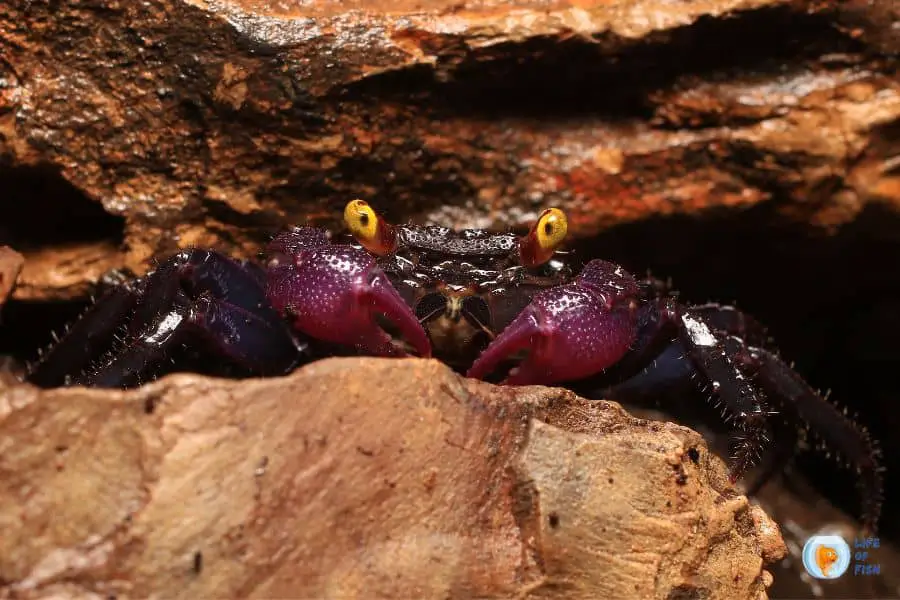
One look Care guide
Jump To
- 1 One look Care guide
- 2 Why do they call them vampire crabs?
- 3 Vampire crab lifespan
- 4 Are Vampire crabs friendly?
- 5 Vampire crab behavior
- 6 Vampire crab varieties
- 7 Vampire crab care
- 8 Can a crab live in tap water?
- 9 Vampire crab breeding
- 10 Vampire crab diet?
- 11 Is vampire crab poisonous?
- 12 Can vampire crabs live with fish?
- 13 Can vampire crabs live with shrimp?
- 14 How many vampire crabs can live together?
- 15 Can Vampire crabs be kept alone?
- 16 Related questions
| Scientific name | Geosesarma Dennerle |
| Common name | Vampire crabs |
| Care level | Easy |
| Native to | small islands in the Indian Ocean. (Java, Sulawesi, Riau, and Krakatau) |
| Type | Semi-terrestrial, Freshwater |
| Color | orange, red, green, and blue |
| Tank size | 10 gallons |
| Preferred temperature | 70°-82° Fahrenheit |
| Other water parameters | Ammonia, nitrite : 0 ppm pH:7.5-8 Hardness 0 to 10 dKH |
| Size | 2-3 inches |
| Growth rate | Moderate |
| Temperament | Peaceful |
| Recommended tank mates | Hermit crabs, Guppies, Mollies , Fiddler crabs |
| Preferred food | Bloodworms, Brine shrimp, larvae, earthworms, and commercial dry foods like pellets |
| Feeding frequency | Once a day |
| Breeding | By eggs |
Why do they call them vampire crabs?
They get their name because they look like vampires because of their two big fangs that stick out of their mouths and their yellow eyes.
Vampire crab lifespan
The lifespan of vampire crabs is a bit low. The maximum lifespan of a typical captive vampire crab is about two years. Vampire crabs have an average lifespan of five years in the wild.
However, this time period can be different depending on various factors. A poorly maintained environment can lead to illness and significantly reduce a person’s life expectancy.
Are Vampire crabs friendly?
Both kids and adults can have these crabs as pets. They add excitement and fun to any home and provide hours of entertainment. If you are looking for an unusual pet, this crab may be a perfect choice!
Vampire crab behavior
Vampire crabs have a very fitting name. Like vampires, they are largely nocturnal. They spend most of their time hiding in a darker spot throughout the day to avoid the light. When the sun goes down, they start moving. During the night, they will explore the tank and spend time on land and in water. It is normal that they lay stand still for hours in their preferred spot and therefore, don’t be alarmed by seeing them motionless for hours.
They try to eat other species or anything else they believe is invading their territory because they are aggressively territorial. As for temperament, Vampire crabs can show quite a bit of aggression toward other creatures. However, it is observed on many occasions that they will stay peacefully with other Vampire carbs.
They will molt several times throughout their lives. It is interesting to see the way they shed their shells to make room for new ones. They need substantial hiding places to hide during the molting phase. As a result, make sure they have plenty of plants to hide in. You can also add a sandy substrate too. When they molt, some crabs prefer to hide underground to avoid being seen. They are very vulnerable just after the molting, as their new shells are not firm.
For the first six months of their lives, they will molt a lot. After that, it happens once a month on average. Don’t miss this event if you are crab enthusiastic!
In conclusion, Vampire crabs are friendly and make great pets for children and adults. They are a fantastic option for anyone looking for a fun and distinctive pet.
Vampire crab varieties
There are 56 recognized Vampire crab species. Although they are very popular in the aquatic industry, they were not popular in the scientific community until recent years. Therefore, scientists believe there should be more species yet to be found.
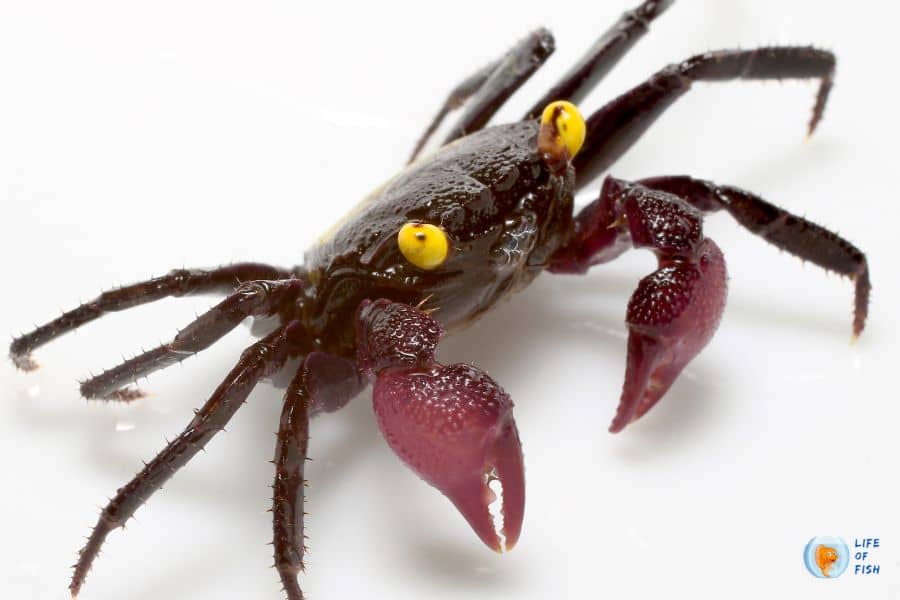
Vampire crab care
Vampire crab size
You may be surprised to know their actual size is smaller than you ever imagined. These crabs appear bigger than they actually are in the pictures for some reason. The average size of a Vampire crab is about 2 inches wide, including the leg span. Actually, the size of their main body, which is called a carapace in zoology, is only about one inch wide. You need to get close to look at them clearly!
Vampire crab tank size
Since they are small, they don’t need a huge space. Vampire crabs need tanks that are at least 10 gallons in size. Some care guides recommend a 5-gallon tank as well. Even if this species is very small and doesn’t move actively, they get stressed in a small room. This is because, in their natural environments, space is not confined, whereas, in a 5-gallon tank, their space is very confined, which makes them stressed. On the other hand, in a small space, the chances of encroachment on their territory are high. There may be fights for space as well.
How many vampire crabs should be kept together?
They live peacefully with the same species. As a result, the number of crabs you should keep in a tank will vary depending on tank size and other factors such as meals; however, you should keep at least three crabs to observe their social behavior. Their peaceful temperament might change when they are going to breed. The males might fight with other males to find a female.
Tank setup
The secret to keeping vampire crabs healthy, like many other aquarium inhabitants, is to mimic their natural habitat in the wild. Therefore, you need to adjust the tank conditions to mimic their natural environmental conditions.
The first thing you need to know is Vampire crabs are not purely aquatic creatures. They are semi-terrestrial, meaning they can live in both aquatic and terrestrial environments. Therefore, you need to provide them with a special aquarium, which allows them to stay in the water and on land. Aquarists strongly recommend going for a paludarium setup rather than your typical aquarium. The majority of the time that vampire crabs spend on land You must therefore provide a perch.
The land-to-water ratio, which many aquarists suggest is 80/20, means that you do not need to maintain a large tank with a high water volume.
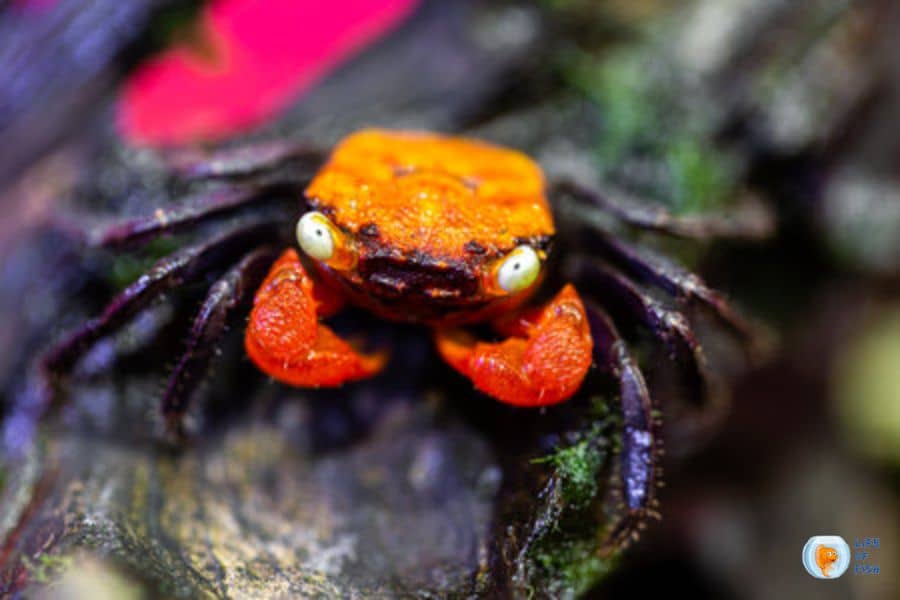
Add plants
The natural environment of Vampire crabs is dense forests, rivers and lakes. Therefore, both the land and water portions need to have a lot of plants. Make sure to install lots of plants in their aquarium, which makes them comfortable. You can do experiments with varieties of various plants, as no research has found that people are keen on a special variety of plants.
Further, there is no need to worry about the plants, as they do not eat the live plants. Some popular plant varieties for the tank are Java ferns and Anubias nana. However, they eat dead plants, and it also makes you not worry about detrimental matters either. Driftwood, rocks, and other types of cover should be added to the water portion as well.
Some aquarists suggest putting coconut husks as it is a great substrate for vampire crab tanks. It helps keep the humidity levels high and provides your crab with some shelter. Actually, terrascaping projects benefit greatly from the addition of these crabs. You can also use small ceramic house ornaments to help your crab feel at home.
Substrate
Besides the plants or the hiding spots, the substrate is the next important thing. They prefer a fine sand substrate, as they burrow themselves from time to time. Especially during molting, some crabs burrow themselves. Sand that is finer in texture is less dangerous and easier to move. Sand is also perfect for establishing a natural elevation for the dry portion.
The alternative method of making land for them is to use a floating perch or large platform to build the land. Many paludariums have integrated shelves to make this easier. The most important thing to remember is that these crabs are very sensitive to chemicals. Therefore, make sure not to use substrates that contain chemicals or have been treated with chemicals.
Filter system
Another important thing is to install a filter for the water portion of the tank. Good filtration is a must for a crab’s tank as they produce a high amount of fecal matter.
Some recommended filters are:
- Canister Filters: for tanks up to 125 gallons.
- HOB Filters: HOB filters (stand-alone) are good for tanks up to 55 gallons.
Apart from them, you can use the RO/DI system if you are using salt water for the tank. A good rule of thumb is to clean your filter every two weeks.
The point at which many owners fail when taking care of Vampire crabs is that they cannot maintain the appropriate humidity levels for the land portion. You should install a humidifier to keep the humidity level at 75 percent. Apart from using a humidifier, you can mist your vampire crab regularly using a spray bottle filled with water. Another method is to add some live plants to your tank, as live plants help to keep the humidity levels high.
They also need a temperate environment, so they therefore need to install a tank heater too. A vampire crab tank should be kept between 70° and 82° Fahrenheit. The Fluval E 300w Heater and Aquarium Pharmaceuticals 100 heater are suitable heaters for the crab’s tank. You can use the Fluval E 300 W heater for tanks up to 30 gallons.
There is an automatic shut-off feature, so you won’t have to worry about it getting too hot. Aquarium Pharmaceuticals’ 100-watt heater can be used for tanks up to 20 gallons. It also has an adjustable thermostat which prevents your tank from overheating.
Although they don’t need a lot of light to survive, vampire crabs do need some light. It is recommended to use fluorescent light bulbs that are designed for reptile tanks. Your Crab will receive just the right amount of light from this without it being too harsh.
Finally, a very important thing is to put a tank lid on because your crabs may escape from the tank at night as they crawl actively. Also, some other pets may enter the tank to prey on your crabs.
To keep your tank clean, you should remove any uneaten food and waste material from the tank daily. Use a gravel vacuum to clean the bottom of the tank. This will facilitate the removal of any accumulated waste or debris.

Water quality condition
You do not need to maintain a lot of water in your crab tank, due to their unique tank setup requirements. Like many other invertebrates, Vampire crabs are sensitive to extreme changes in water quality. As a result, regardless of how much water you use, you must pay close attention to water quality. Bad water quality makes your crabs unhealthy, and ultimately, it can cause their death too.
Vampire crabs are from tropical freshwater environments, so you should provide them with lightly alkaline and pretty warm water.
As described before, Vampire crabs need warm water, which should be in the range of 70°F to 82°F. In the above temperature range, temperatures in the middle are ideal for crabs. The preferred pH range is between 7.5 to 8 indicating they need slightly alkaline water. The water hardness should be in the range of 0 to 10 dKH.
Partially changing the water will be required once per month. It is advised to change up to 40% of the water each time to maintain low levels of ammonia and nitrate.
Ammonia and nitrite levels should be 0 ppm
If you stick to these parameters, you can keep your crabs healthy and happy.
Can a crab live in tap water?
Yes, you can keep the Vampire crabs in tap water as long as the chlorine content of the water is in the recommended range. You can also keep tap water in a basket for a day or two before using it for the crab tank so that you can get safe water as the chlorine will evaporate. Actually, the problem associated with the use of tap water by the vampire crabs is not the chlorine, but the heavy metals and unknown ions. However, generally, potable tap water is devoid of heavy metals and should be safe.
In addition, it is better to use a water conditioner to remove chlorine and chloramine from the water and other harmful toxins if you are using tap water. Water conditioners, which are specifically designed for reptile tanks, are recommended for the crab’s tank. This will help ensure that your vampire crab’s skin does not come into contact with any harmful chemicals.
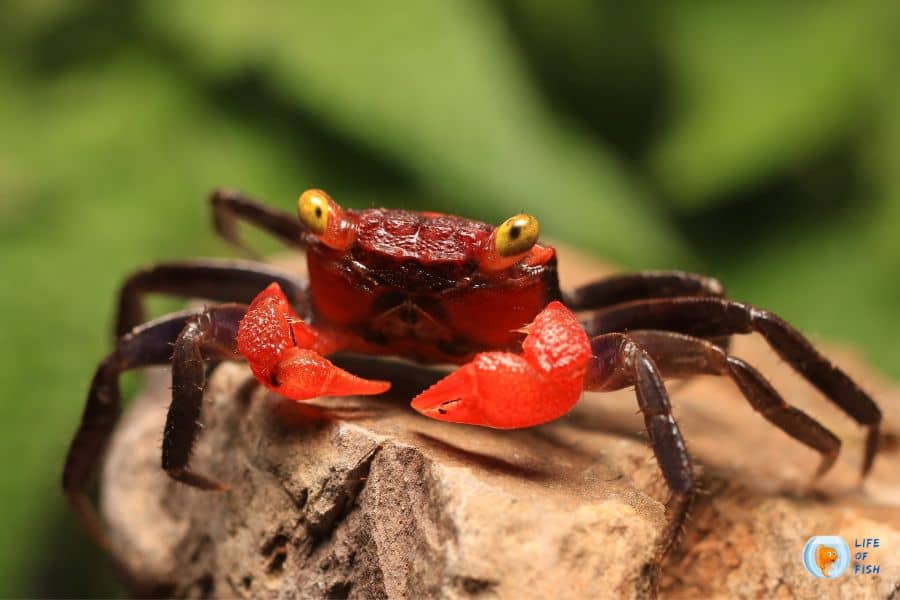
Vampire crab breeding
Vampire crab male or female identification
It is not easy to distinguish between male and female Vampire crabs unless you have a trained eye. Although both the males and females have bright colors, the claws of male Vampire crabs are a bit lighter in color. Also, the male crabs are slightly larger than the females. The most obvious and distinguishable difference between the two sexes is the abdominal flap. Observe the underside of the crab. Females have a wide, rounded flap, whereas males have a more pointed flap.
Another way to identify the gender of vampire crabs is by examining their genital pouches. In males, these pouches are large and triangular, while they are small and round in females. Sometimes, you’ll spot some fertilized eggs under the flap, meaning the crab is a female
How to breed them
Many people try to breed Vampire crabs to compensate for their relatively short lifespan. However, to be frank, breeding them in captivity is a real challenge. As their life span is short, they sexually mature at about six months old, and they’ll continue to reproduce for the remainder of their lives.
The male crab fertilizes the eggs by climbing on top of the female crab while the female crab is carrying eggs. The female vampire crab will lay her eggs in a safe place. The female will carry between 20 and 80 eggs for about a month. It takes approximately one month to hatch the fertilized eggs.
If you intend to breed them, you may need a breeding tank as well as a tank for the juveniles because they show cannibalistic behavior. The breeding tank should be at least 10 gallons in size. The tank should be filled with plenty of hiding places, so the crabs can feel safe. You should also provide many different types of food so the crabs can breed.
They are most likely to breed in the spring or summer months. You can keep the water temperature at about 80 °F to increase your chances of breeding.
How many babies do they have
Though there is less data on breeding, it is estimated that they can produce 20 to 80 fully formed baby crabs in single breeding.
vampire crab baby care
After birth, they are very independent. Though some will stick around the mother for a while, they do not care for their young. As mentioned earlier, Vampire crabs are cannibals. Therefore, it’s best to remove them and put them in a separate tank once the youngsters appear, as the parents and other tank residents may eat them. The youngsters also eat themselves. Weaker baby crabs may become a meal for other baby crabs. Make sure to provide plenty of hiding places for the vampire crab babies, too, to avoid cannibalism.
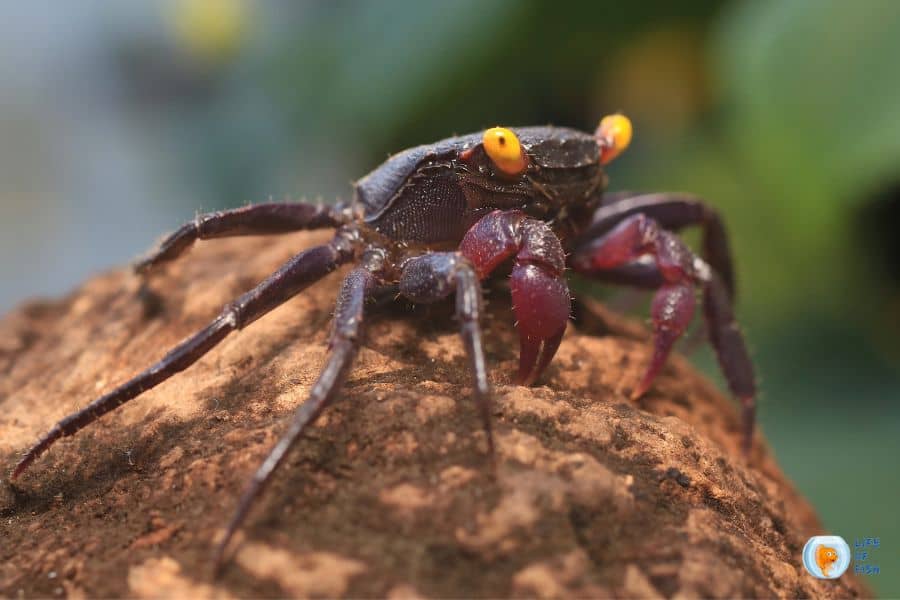
Vampire crab diet?
It is essential to give your crabs a good, nutritious diet. High-quality food keeps them healthy, encourages growth, and helps build a strong exoskeleton after molting. Fortunately, feeding them is not hard, as they are not picky eaters at all. They’re natural omnivores that usually take what they can get in the wild.
Insects and plant detritus are the main choices for food in their natural environment. Actually, they act as scavengers in the wild and they even eat dead small fish. Their food choices remain the same when they are in captivity too. They may love to eat live food such as bloodworms, brine shrimp, larvae, and earthworms.
However, that does not mean they will not accept dry commercial foods. These critters will chow down on dry flakes, algae wafers, and more without any issues. Experienced Aquarians recommend providing them with a mixture of both live and dry foods.
It is very important to provide them with calcium-rich foods. Calcium is essential for them to have strong shells. You need to provide them with more calcium-rich foods during their molting stage. Things like spinach, peas, and broccoli are all good calcium sources. Avoid feeding them avocados, rhubarb, and peaches that may be toxic to them.
Is vampire crab poisonous?
No, they are not known as poisonous
Can vampire crabs live with fish?
Although the best tankmates for Vampire crabs are other Vampire crabs, they are social creatures and live peacefully with some species of fish, such as guppies and mollies. However, the most recommended method is to keep them in a species-only environment. You should also avoid keeping them with aggressive or territorial fish species, as they may hurt or kill the Vampire crabs. Further, bear in mind that Vampire crabs will hunt small fish, so avoid any slow bottom-dwellers and observe very carefully.
Can vampire crabs live with shrimp?
Yes, you can keep freshwater shrimp with them. However, be aware small shrimps might be food for them
How many vampire crabs can live together?
It actually depends on the space, food, and other requirements you can provide. They live peacefully except during their breeding period.
Can Vampire crabs be kept alone?
You can keep them alone, but due to their social nature, it is recommended that they be kept in groups.
Related questions
Are vampire crabs hard to keep?
No. They are very easy to keep. However, you should provide them with good environmental conditions and food.
Are Vampire crabs fully aquatic?
No, they are semi-terrestrial creatures, who live in both water and land
Do vampire crabs need saltwater?
No, they are freshwater crabs and do not need a saltwater
Where does vampire crab come from?
These crabs come from small islands in the Indian Ocean. They have been found living in Java, Sulawesi, Riau, and Krakatau. However, they’ve also been distributed throughout Asia and the Western Pacific.
How long can a crab live out of water?
They are semi-terrestrial creatures and can live without water even for 24 hours
Read Next : Green Tiger Barb Care | Tank Prep. | Breeding | Feeding | Tank Mates |
